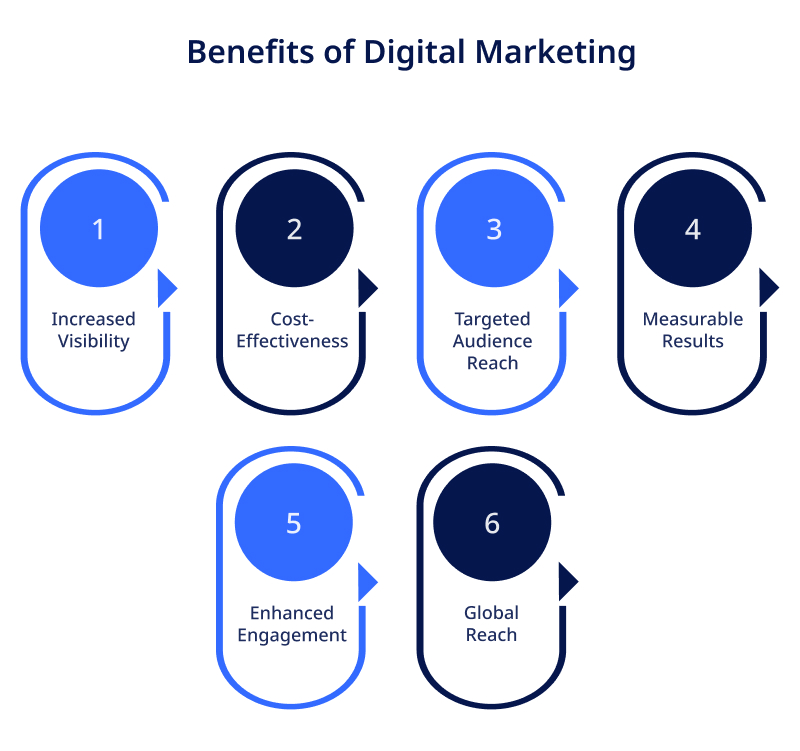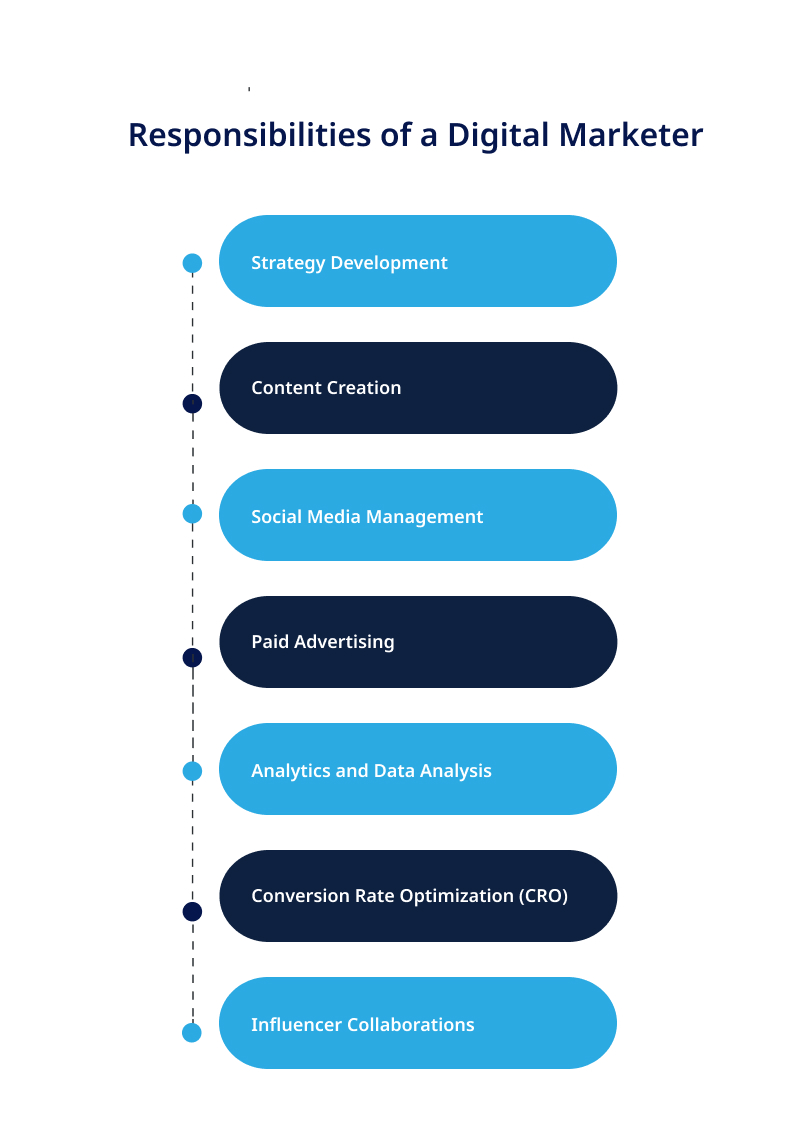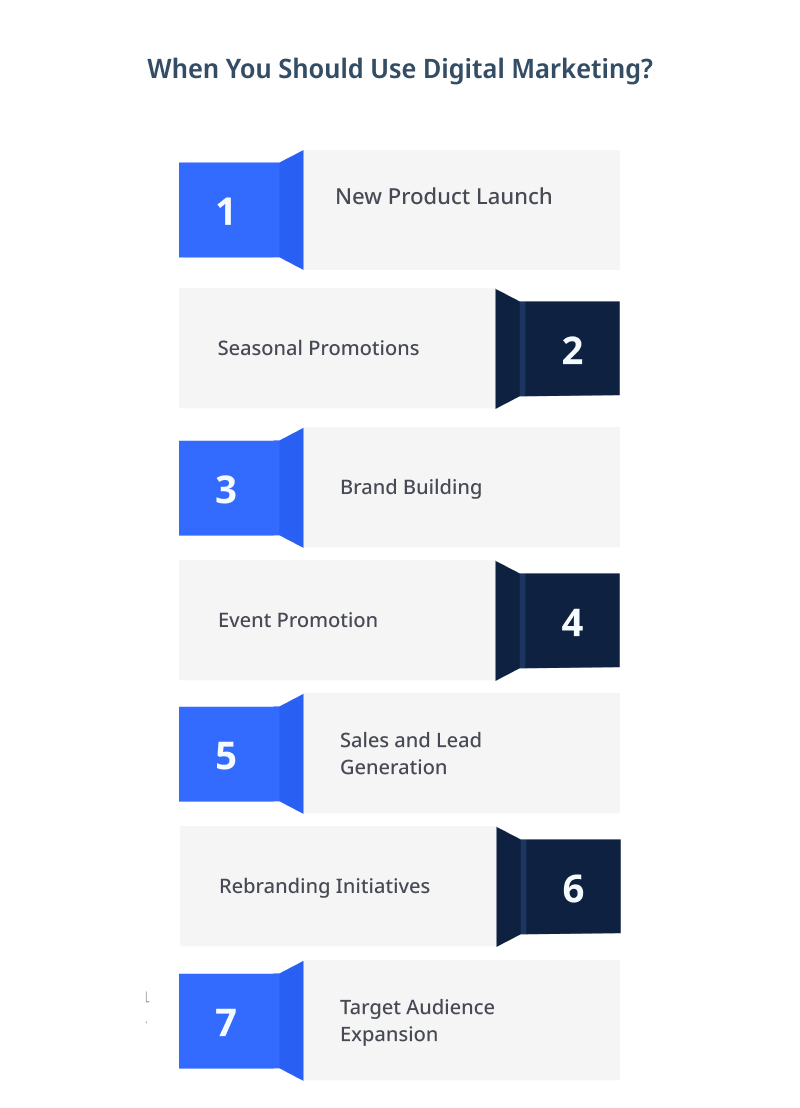Feeling lost in the world of digital marketing?
Navigating the complex and ever-changing landscape of digital marketing is no easy feat. Although different platforms, tactics, and tools available to help businesses make their mark online, this might not be a practical solution to many problems. What they need is expert guidance and a well-planned strategy to move ahead.
Picture this: instead of struggling, you’re confidently mastering the internet to grow your business. You know exactly what to do, where to go, and how to make it work.
That’s exactly what this A-Z of Digital Marketing guide is about. We’ll break down everything you need to know about digital marketing, no confusing terms or hidden secrets. Just simple steps and practical tips to launch your online presence like a pro.
Whether you’re a seasoned marketer or a beginner, our guide to digital marketing will provide you with the knowledge and skills you need to succeed online.
Ready to ditch the confusion and unlock your online potential? Let’s dive in!
Table of Contents
What is Digital Marketing?
Digital marketing uses technologies and channels to promote products, services, or brands to a target audience. It involved online activities like SEO, social media marketing, content marketing, email marketing, and online advertising.
The objective is to connect and engage with the audience using the internet and electronic gadgets to interact and engage.
Companies may reach a worldwide audience with digital marketing, monitor performance with analytics, and adjust their strategy based on real-time data.
Why is Digital Marketing Important?
Digital marketing cannot be overlooked in today’s rapidly evolving digital world. It creates a dynamic and efficient connection between companies and their target market. In this digital marketing guide, we will highlight its primary benefits:
Increased Visibility: By utilizing social media marketing and search engine optimization (SEO) tactics, companies can ensure their target audience can easily find and notice them.
Long-term success is facilitated by increased visibility as it not only generates more visitors but also creates brand authority online.
Cost-Effectiveness: Compared to conventional methods, online advertising platforms, social media, and email marketing enable businesses to access a wider audience at a substantially reduced cost.
Additionally, digital marketing services offer the freedom to allocate money and strategically optimize campaigns based on performance metrics.
Because of its affordability, focused digital tactics can help small firms with tight budgets compete and generate a significant return on investment (ROI).
Targeted Audience Reach: Digital marketing allows businesses to target their audience precisely based on demographics, interests, behavior, and other criteria.
It guarantees that promotional efforts are focused on those more likely to be interested in the provided goods or services, as opposed to traditional marketing techniques that spread their net widely.
This focused strategy improves the effectiveness of marketing campaigns and increases return on investment.
Measurable Results: The intrinsic measurability of digital marketing is one of its main benefits. Businesses may monitor campaign performance in real-time using various analytics tools and indicators.
Thus, key performance indicators (KPIs), including website traffic, conversion rates, and engagement levels, may be tracked by marketers.
Businesses can refine their strategies for maximum success by using data-driven decision-making, which is made possible by the capacity to measure results. This accountability and transparency help to keep marketing initiatives getting better over time.
Enhanced Engagement: Digital marketing services are crucial for businesses to engage their target audience more.
Businesses can give customers individualized and interactive experiences via various digital platforms. Email campaigns, interactive content, and social media platforms enable firms to connect more intimately with their audience.
Companies may establish enduring relationships, acquire valuable insights about client preferences, and customize their strategy for maximum impact by cultivating engagement.
Global Reach: Digital marketing offers firms of all sizes a global reach, which is one of its main advantages. By utilizing online media, businesses may target customers globally and expand their reach beyond physical borders.
Companies may reach a wider audience, penetrate foreign markets, and grow their clientele through digital marketing services like social media marketing, online advertising, and SEO.
This worldwide reach creates fresh chances for expansion and variety in today’s linked digital environment.
Types of Digital Marketing
Within the broad domain of digital marketing, companies utilize several approaches to establish a connection with their intended audience, amplify brand awareness, and stimulate sales. The following are essential types of digital marketing that companies use:
1. Search Engine Optimization (SEO)
By using targeted keywords, improving website structure, and acquiring high-quality backlinks, search engine optimization (SEO) seeks to raise a website’s position in search engine results pages (SERPs).
This organic approach increases the likelihood of attracting relevant and focused visitors and improving online exposure.
2. Content Marketing
Content marketing focuses on producing and disseminating worthwhile, timely, and consistent material to draw in and keep the interest of a target audience. This material can be presented in several ways, such as blog entries, essays, films, infographics, etc.
In addition to increasing organic traffic, well-executed content marketing shows credibility and trust with the target audience, cultivating enduring partnerships.
3. Social Media Marketing
Social media networks like Twitter, Instagram, etc, are used to communicate with people, build brand awareness, and drive more visitors to business websites.
It frequently combines community building, sponsored advertising, and original content production to develop a significant online presence.
4. Email Marketing
It is an effective instrument for establishing and maintaining connections with clients. Newsletters, special offers, product updates, and personalized content are all examples of email marketing.
Email marketing works well for promoting conversions, building brand loyalty, and informing customers of new products and advances since it can reach a big audience quickly.
5. Pay-Per-Click (PPC) Advertising
In the pay-per-click (PPC) digital marketing paradigm, marketers are charged a fee whenever someone clicks on an ad.
Businesses can bid for ad placement in search engine sponsored links when a user searches for a relevant keyword; it’s an affordable way. PPC is a popular option because of its instant visibility and payment for clicks alone.
6. Affiliate Marketing
In affiliate marketing, a company collaborates with outside affiliates to market the company’s goods and services. Affiliates receive payment for each sale, click, or lead they generate.
Affiliates are encouraged to aggressively promote the items by this performance-based model, which benefits affiliates and businesses. It is extensively employed in content marketing and e-commerce techniques.
Looking for new ways to expand your business reach? Connect with us to leverage digital marketing for sustainable growth and increased revenues.
How to Use Digital Marketing?
In the dynamic landscape of online marketing guide, navigating through many channels and strategies requires a comprehensive approach. Here’s an A-Z beginner guide to digital marketing to your business’s advantage:
1. Set Clear Goals
Digital marketing effectiveness relies on well-defined goals. Clearly state the goals you have for your digital marketing campaigns.
Your plan will be guided by creating specified, measurable, attainable, relevant, and time-bound (SMART) goals, which can be used to grow brand awareness, drive website traffic, or raise sales.
2. Identify Your Target Audience
Creating successful digital marketing campaigns requires a thorough understanding of your target audience. Make detailed buyer personas that describe your prospective client’s characteristics, habits, and interests.
To make your digital marketing efforts more engaging and personalized, ensure your channels, messaging, and content are tailored to your audience. Frequently update these personas depending on data and market shifts to remain current.
3. Choose the Right Channels
Determining which platforms best fit your target market and corporate goals is key to using digital marketing efficiently. To find out where your audience is most active, do extensive research.
Choosing the appropriate channels, be it email, social media, search engines, or other means, guarantees that the target audience will see your marketing efforts. Consider your target market’s tastes, behavior, and demographics to choose the best channel.
4. Create Engaging Content
An effective digital marketing plan starts with content. Publish insightful content that connects with and addresses your audience’s issues.
The secret is to produce content that draws viewers in and promotes interaction, whether it be through blog entries, social media updates, videos, or email newsletters.
Use relevant information, storytelling, and images to keep your audience interested. Reliable and engaging content builds trust and loyalty with current clients while drawing in new ones.
5. Optimize for Search Engines (SEO)
Effective SEO services and strategies enhance your online visibility and drive organic traffic. It involves aligning your website’s meta-information, content, and structure with search engine algorithms.
Researching keywords, optimizing the website, constructing backlinks, and ensuring the site is mobile-friendly are all important components.
By putting SEO best practices into effect, your company’s visibility among prospective clients increases as it ranks higher in search engine rankings.
6. Utilize Social Media
Social media platforms effectively establish a connection with your audience, increase brand recognition, and stimulate interaction. Develop a social media plan that aligns with your target market and business objectives.
To increase your reach, engage with your followers, provide worthwhile and pertinent information frequently, and use paid advertising possibilities.
User-generated content is encouraged, brand loyalty is increased, and social media marketing offers insightful data on consumer trends and preferences. Including social media in your digital marketing initiatives promotes consumer connection and helps you establish a robust online presence.
Follow for more updates on achieving a balanced approach between paid and organic search strategies.
7. Implement Email Marketing
Another step to maximize the potential of email marketing is to create a segmented email list according to user preferences and actions.
Create interesting and individualized email messages that benefit the receivers. Use attention-grabbing headlines, eye-catching content, and apparent calls to action (CTAs).
Track email success indicators like click-through and open rates and continuously fine-tune campaigns according to user interactions.
8. Build a Strong Online Presence
Establishing a robust online presence involves several key steps:
Improve your website’s search engine optimization (SEO) to get more visibility in search results.
Generate and consistently update pertinent, high-quality material for various online platforms.
Use social media to interact with your audience, sharing insightful information and building connections.
To reach more people, use internet advertising strategically. Keep an eye on internet reviews and actively maintain your company’s reputation. Regularly evaluate data and insights to get the most out of your digital marketing plan.
9. Engage with Your Audience
Meaningful interaction with your audience is essential in digital marketing to foster brand loyalty and increase conversion rates. Use a range of venues, such as social media, email marketing, and interactive content, to establish a two-way communication flow.
Encourage community and trust by swiftly responding to messages, comments, and inquiries. Connect with your audience beyond transactional engagements by customizing your content to speak to their preferences and pain areas.
In addition to improving brand perception, regularly interacting with your audience provides insightful information that can be used to improve your marketing tactics.
What Does a Digital Marketer Do?
Digital marketers are pivotal in shaping a brand’s online presence and driving engagement in the ever-evolving digital landscape. Here’s a breakdown of the key responsibilities of having a digital marketing guide:
1. Strategy Development
- Conduct in-depth market research to comprehend the target market and market trends.
- Examine rivals and find areas where digital marketing methods can be implemented.
- Establish measurable, unambiguous goals that align with the overarching corporate goals.
- Create a thorough strategy for digital marketing that includes channels like email marketing, social media, and SEO.
2. Content Creation
- Provide pertinent and interesting material for a range of digital platforms.
- Write enticing material for websites, social media posts, and adverts.
- Ensure the material reflects the brand’s values, voice, and overall marketing strategy.
- Use multimedia components, such as pictures and videos, to increase the impact of your content.
3. Social Media Management
- Create and carry out a plan that aligns with your brand’s goals.
- Encourage audience participation by leaving remarks, sending messages, and starting conversations.
- To monitor social media performance and adjust tactics, use analytics tools.
- Run social media campaigns to boost audience engagement and brand awareness.
4. Paid Advertising
- Create detailed planning for cross-platform paid advertising campaigns.
- To guarantee effective spending, keep an eye on and oversee advertising budgets.
- Create eye-catching ads to draw in the intended audience.
- Use data to examine how well-sponsored campaigns perform and modify your approach for improved outcomes.
5. Analytics and Data Analysis
- To monitor and evaluate the success of your websites and campaigns, use technologies such as Google Analytics.
- Utilize data to derive meaningful insights that can enhance marketing tactics and ROI.
- Recognize patterns, trends, and user behavior to maximize your efforts in digital marketing.
- Use data-driven decision-making to create campaigns that are more focused and successful.
6. Conversion Rate Optimization (CRO)
- To optimize website elements for improved conversion rates, use A/B tests.
- Examine user journeys to find where the conversion funnel needs improvement.
- Adjust your website’s content, CTAs, and appearance to improve conversion rates.
- Iterate and improve your strategy constantly using CRO insights.
7. Influencer Collaborations
- Find and interact with influencers who are associated with the product or brand.
- Establish and maintain connections with influencers to facilitate genuine cooperation.
- Make the most of influencers’ credibility and reach to increase brand awareness.
- Monitor and assess how influencer partnerships affect engagement and brand exposure.
Key Differences Between Inbound Marketing vs Digital Marketing
Understanding the differences between digital and inbound marketing is essential to developing successful strategies in modern marketing. Here is a thorough analysis of their variations:
1. Definition
Inbound Marketing: Inbound marketing is centered on drawing in and involving prospective clients with experiences and materials relevant to their requirements.
Digital Marketing: It consists of a wider range of activities, including using digital platforms for promotion, including websites, social media, email, and search engines.
2. Approach
Inbound Marketing: It produces content that speaks to the target audience’s unique interests and problems to entice them to the brand.
Digital Marketing: Consists of a broader range of approaches, such as email campaigns, paid advertising, and both inbound and outbound tactics.
3. Customer Interaction
Inbound Marketing: Inbound marketing strongly emphasizes establishing long-lasting client connections by offering insightful knowledge and practical solutions.
Digital Marketing: Digital marketing is centered on using various digital media to reach a larger audience, frequently using a more transactional strategy.
4. Content Creation
Inbound Marketing: Inbound marketing highly values producing engaging, instructional, and useful content to attract a loyal following.
Digital Marketing: Digital marketing consists of content development, but it can also include advertising and promotional content meant to elicit a quick response.
5. Lead Generation
Inbound Marketing: Leverages content to attract and nurture leads gradually through the sales funnel.
Digital Marketing: Uses email marketing, social media campaigns, and sponsored commercials, among other channels, to generate leads.
6. Sales Funnel
Inbound Marketing: Inbound marketing is centered on taking potential customers on a customized, educational journey to build lasting relationships.
Digital Marketing: Digital marketing consists of a wider range of tactics, frequently aimed at accelerating conversions and closing deals immediately.
When to Use Digital Marketing?
Digital marketing guide is a dynamic tool that adapts to different business needs and objectives. Knowing when to deploy digital marketing strategies can significantly impact their effectiveness. Here are vital scenarios when leveraging digital marketing proves beneficial:
New Product Launch: Digital marketing works especially well when introducing a new product. It enables companies to use various internet platforms to generate excitement and expectation.
The target audience can be excited and aware of a campaign using techniques like influencer collaborations, email marketing, and social media teasers.
Digital platforms are perfect for optimizing the impact of a new product introduction since they offer a rapid and extensive reach.
Seasonal Promotions: During seasonal promotions and events, digital marketing is essential. Businesses can use digital channels to swiftly reach a broad audience for special occasions, back-to-school marketing, and Christmas sales.
It is possible to carefully use email marketing, social media promotions, and tailored online advertising to coincide with the seasonality of customer behavior.
Companies may take advantage of rising consumer spending trends and remain in consumers’ minds during important purchasing times.
Brand Building: Digital marketing is crucial to building and enhancing your brand’s online presence. Digital marketing gives you the means to present your brand identity, regardless of whether you are a startup or an established company trying to rebrand.
You may establish a recognizable and appealing brand image that appeals to your target market through online advertising, social media platforms, and content marketing.
Event Promotion: Digital marketing becomes an effective promotional tool when you hold an event, be it a physical gathering, webinar, or the debut of a new product.
Use social media, email marketing, and content production, among other online platforms, to create excitement about your event, draw people in, and increase its visibility.
With the help of digital marketing, you can efficiently and swiftly reach a large audience, guaranteeing that your event receives the recognition it deserves.
Sales and Lead Generation: A digital marketing guide works especially well if your main objective is increasing sales and generating leads. You can connect with a certain group of people interested in your goods or services by running targeted internet ads.
Build a sales funnel that draws in and converts prospective clients by utilizing techniques like social media advertising, email marketing and SEO.
Using digital platforms, you can improve overall conversion, measure and analyze user interactions, and optimize advertising.
Rebranding Initiatives: Digital marketing is essential for communicating and reiterating the new brand identity when your company rebrands.
Use various online platforms to interact with your audience, present the redesigned brand image with the help of a logo maker, and raise awareness of the rebranding.
Email campaigns, content marketing, and social media platforms can all be effective strategies for shifting your brand’s position in the marketplace.
Real-time communication made possible by digital marketing enables you to successfully execute rebranding initiatives, respond to client input, and create excitement.
Target Audience Expansion: Digital marketing is essential to reach new demographics and broaden your target audience. You may carefully target and interact with various audience segments using channels like search engine marketing and social media advertising.
Digital platforms give you the tools and insights to understand your growing audience better and create more individualized and successful marketing campaigns.
Digital marketing gives you the reach and flexibility to successfully expand your audience, whether expanding into new areas or broadening your current clientele.
Digital Marketing Examples
Brands are constantly pushing the envelope to engage consumers. Here are some examples of how businesses use digital channels to improve their online visibility:
1. Nike’s Social Media Campaigns
Nike is well known for their creative and effective social media marketing strategies. It uses interactive campaigns, motivational tales, and eye-catching content to engage its audience on social media sites like Facebook, Instagram, and Twitter.
Some noteworthy examples include campaigns highlighting well-known athletes, promoting user-generated material, and using popular hashtags. These tactics not only increase brand awareness but also help Nike fans feel very much like a community.
2. Dollar Shave Club’s Viral Video
Dollar Shave Club’s witty and creative viral video marketing upended the razor market. The company’s viral “Our Blades Are Great” video showcased the brand’s attitude and value proposition.
In addition to capturing viewers’ attention, this clever and enjoyable strategy effectively conveyed the ease of use and affordability of Dollar Shave Club’s membership plan.
This film’s success exemplifies how effective digital marketing, especially video content, can elevate a brand and connect with viewers.
3. Airbnb’s Content Marketing
Airbnb is a master at content marketing because it produces insightful and interesting material that does more than just advertise its lodgings.
The company creates user-generated content, travel guides, and neighborhood insights that offer a comprehensive travel experience in addition to showcasing places.
Using social media, movies, and blog articles, Airbnb creates a community and establishes itself as an authority on travel, encouraging user loyalty and trust.
4. Starbucks’ Mobile App and Rewards Program
Starbucks uses its rewards program and mobile app to boost digital marketing. The software gives users a smooth and customized experience by combining mobile ordering, payment, and a loyalty program.
Recurring purchases are encouraged by the rewards program, while user convenience is increased by the app’s features, including fast payment and order personalization.
Starbucks creates a personalized and engaging relationship with its customers by using data from the app to customize promotions and send targeted offers and recommendations.
5. Red Bull’s Content Creation
Red Bull is a prime example of creative content production for online advertising. Red Bull uses content marketing techniques to do more than just run ads. They create exciting and captivating content, like stunts and extreme sports events.
By fostering a community around their target market, this strategy helps them market their business and forges a strong brand identity linked to excitement and adrenaline.
6. Amazon’s Personalized Recommendations
Amazon leverages personalized recommendations as a powerful digital marketing strategy. Based on consumers’ browsing and purchase behavior, Amazon offers tailored product recommendations using algorithms and customer data.
It improves customer happiness, boosts user experience, and generates more revenue. Amazon’s focused strategy exemplifies how data-driven customization may increase revenue and engagement in the e-commerce industry.
How can PixelCrayons Help with its Digital Marketing Services?
PixelCrayons offers comprehensive digital marketing services to help businesses establish a robust online presence and achieve their marketing goals.
With a team of experienced professionals, we cover a wide spectrum of digital marketing strategies, including SEO, content marketing, pay-per-click (PPC) advertising, social media marketing, Marketing Services for Tech, and more.
Our team’s expertise is creating impactful digital strategies, optimizing online visibility, driving organic traffic, and generating leads. Connect with us to maximize your online potential and stay ahead in the competitive digital landscape.
We proudly serve clients across various locations, including New York, London, Dubai, Texas, Chicago, San Diego and Toronto providing effective digital marketing solutions to meet diverse business needs.
Final Words
So, what does digital marketing mean to you? By now, you have a firm grasp on the digital marketing guide, its foundational principles, and immediate start opportunities.
You should be confident to try a little of everything because many possibilities are available based on your interests and experience. You’ll eventually discover your strengths and the strategies most likely to yield the desired outcomes.













